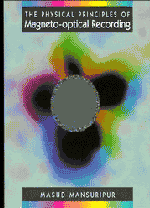Book contents
- Frontmatter
- Contents
- Preface
- 1 Overview of Optical Data Storage
- 2 Optics of Gaussian Beams
- 3 Theory of Diffraction
- 4 Diffraction of Gaussian Beams from Sharp Edges
- 5 Optics of Thin Films and Multilayers
- 6 Magneto-optical Readout
- 7 Effects of High-numerical-aperture Focusing on the State of Polarization
- 8 Computer Modeling of the Optical Path
- 9 Noise in Magneto-optical Readout
- 10 Modulation Coding and Error Correction
- 11 Thermal Aspects of Magneto-optical Recording
- 12 Fundamentals of Magnetism and Magnetic Materials
- 13 Magnetostatics of Thin-film Magneto-optical Media
- 14 Mean-field Analysis of Amorphous Rare Earth–Transition Metal Alloys
- 15 Magnetization Dynamics
- 16 Origins of Coercivity
- 17 The Process of Thermomagnetic Recording
- 18 Media Characterization
- References
- Index
12 - Fundamentals of Magnetism and Magnetic Materials
Published online by Cambridge University Press: 07 September 2010
- Frontmatter
- Contents
- Preface
- 1 Overview of Optical Data Storage
- 2 Optics of Gaussian Beams
- 3 Theory of Diffraction
- 4 Diffraction of Gaussian Beams from Sharp Edges
- 5 Optics of Thin Films and Multilayers
- 6 Magneto-optical Readout
- 7 Effects of High-numerical-aperture Focusing on the State of Polarization
- 8 Computer Modeling of the Optical Path
- 9 Noise in Magneto-optical Readout
- 10 Modulation Coding and Error Correction
- 11 Thermal Aspects of Magneto-optical Recording
- 12 Fundamentals of Magnetism and Magnetic Materials
- 13 Magnetostatics of Thin-film Magneto-optical Media
- 14 Mean-field Analysis of Amorphous Rare Earth–Transition Metal Alloys
- 15 Magnetization Dynamics
- 16 Origins of Coercivity
- 17 The Process of Thermomagnetic Recording
- 18 Media Characterization
- References
- Index
Summary
Introduction
Magneto-optical recording is an important mode of optical data storage; it is also the most viable technique for erasable optical recording at the present time. The MO read and write processes are both dependent on the interaction between the laser beam and the magnetic medium. In the preceding chapters we described the readout process with the aid of the dielectric tensor of the storage medium, without paying much attention to the underlying magnetism. Understanding the write and erase processes, on the other hand, requires a certain degree of familiarity with the concepts of magnetism in general, and with the micromagnetics of thin-film media in particular. The purpose of the present chapter is to give an elementary account of the basic magnetic phenomena, and to introduce the reader to certain aspects of the theory of magnetism and magnetic materials that will be encountered throughout the rest of the book.
After defining the various magnetic fields (H, B, and A) in section 12.1, we turn our attention in section 12.2 to small current loops, and show the equivalence between the properties of these loops and those of magnetic dipoles. The magnetization M of magnetic materials is also introduced in this section. Larmor diamagnetism is the subject of section 12.3. In section 12.4 the magnetic ground state of free atoms (ions) is described, and Hund's rules (which apply to this ground state) are presented.
- Type
- Chapter
- Information
- The Physical Principles of Magneto-optical Recording , pp. 392 - 468Publisher: Cambridge University PressPrint publication year: 1995
- 1
- Cited by



